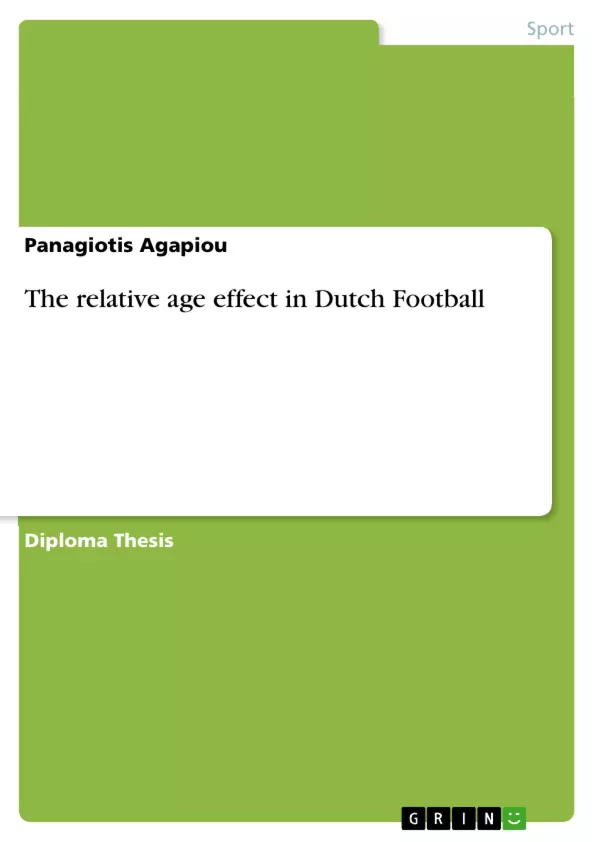The Relative Age Effect (RAE) is a phenomenon that impacts an individual’s outcome. In particular, the RAE in sports favors those athletes that have been born prior to a cut-off date and is detrimental for those who were born later in the same period. The grouping of soccer players in academies benefits the early born football players in the selection for the elite team because of physical advantages that are based on biological maturation. Therefore, evidence suggests that the effect is more likely to be observed in the lower youth categories. This study examines the RAE in the Dutch football leagues by investigating data from the national teams U-15 and U-19 of the national team. A Pearson X^2 test provides evidence that the observed birth date distribution deviates from the expected one, which leads to a skewed birth date distribution. The findings suggest that the early born football players have indeed an age advantage in the selection system in relation to their late born peers. Moreover, there is higher probability that they will become professional in the future. Also, the RAE seems to decrease overtime, but it still exists, even in the elite category.
Table of Contents
- Introduction
- Literature Review
- Methods
- Data and Methodology Approach
- Empirical Analysis
- Results
- Dutch Professional Football
- Youth Categories
- Elite Team
- International Players
- Conclusion
- References
- Web Source
- Appendix
Objectives and Key Themes
This MSc thesis aims to investigate the Relative Age Effect (RAE) in Dutch football, specifically focusing on the overrepresentation of early-born players in youth categories and its impact on their career trajectories. The research seeks to understand how birth date influences performance and selection for elite teams, examining the presence of the RAE in both youth and professional levels. The thesis also explores the potential for mitigating the negative effects of the RAE on late-born players.
- The Relative Age Effect (RAE) in sports
- Overrepresentation of early-born players in youth categories
- The impact of birth date on player performance and selection
- The persistence of the RAE in professional football
- Strategies to mitigate the RAE
Chapter Summaries
- Introduction: This chapter introduces the concept of the Relative Age Effect (RAE) and its implications in education and sports, particularly in football. It explains how the RAE favors early-born players due to their physical and psychological advantages, leading to potential bias in selection processes. The chapter also highlights the need for mitigating the negative impact of the RAE on late-born players.
- Literature Review: This chapter provides a comprehensive overview of existing research on the RAE in sports, focusing on its presence, causes, and consequences. It examines studies that explore the overrepresentation of early-born athletes in elite teams, the role of physical maturation in selection, and the potential impact of the RAE on talent development.
- Methods: This chapter describes the data and methodology used in the study. It details the data sources, including information on youth academy players in the U-15 and U-19 categories of the Dutch national team, as well as professional players. The chapter outlines the statistical methods employed, such as the Pearson X²-Goodness-of-fit test, to analyze the birth date distribution and identify potential overrepresentation.
- Results: This chapter presents the findings of the study, including the results of the statistical analyses. It examines the evidence for the overrepresentation of early-born players in youth categories, and how the RAE may influence their chances of becoming professional players. The chapter also discusses the potential decline in the RAE over time as players progress in their careers.
- Dutch Professional Football: This chapter delves into the analysis of the RAE within Dutch professional football, focusing on youth categories, elite teams, and international players. It examines the presence and persistence of the RAE across these different levels of the sport, providing insights into its impact on player selection and performance.
Keywords
The primary keywords and focus topics of the text include: relative age effect, overrepresentation, soccer, cut-off date, physical advantages, elite team, youth categories, birth date distribution, talent development, professional football, and international players.
- Arbeit zitieren
- Panagiotis Agapiou (Autor:in), 2018, The relative age effect in Dutch Football, München, GRIN Verlag, https://www.grin.com/document/434347



